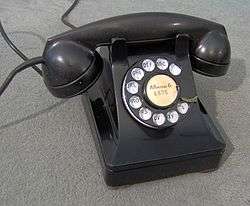Model 302 telephone
The model 302 telephone is a desk set telephone that was manufactured in the United States by Western Electric from 1937 until 1955, and by Northern Electric in Canada until the late 1950s, until well after the introduction of the 500-type telephone in 1949. The sets were routinely refurbished into the 1960s. It was one of the most widely used American combined telephone sets to include the ringer and network circuitry in the same telephone housing.

Design and production
The design of a new desk telephone for the Bell System began approximately in 1930, at the time of introduction of the 102 and 202-type desk telephones, which required two separate enclosures for the telephone circuitry and components. The existing Western Electric telephones used an external subscriber set (subset), containing the ringer and network circuitry, typically mounted on a wall or desk side. New concepts of design and economic efficiency emerged in Europe as well as in the independent market in the US in the 1920s, which combined all components of the telephone in one desk set unit. The model 302 was the first Western Electric telephone to include the ringer and network circuitry in the same desktop unit.
Designed by Bell Telephone Laboratories engineer George Lum starting in the early 1930s,[1][2][3] the 302-type telephone included such design elements of contemporary technology by, for example, the Ericsson model DBH 1001 of 1931, conceived in 1929 by the Norwegian artist and designer Jean Heiberg.[4], and the Automatic Electric type 34 desk telephone, introduced in 1934.

During the early part of the decade, the design evolved and awaited the completion of a newly designed handset, the F1. After field trials in 1936, large-scale deployment commenced in 1937. The model was never completely retired from service in the Bell System, which ceased to exist in 1984.
The model 302 is built upon a rectangular steel base plate on which are mounted the ringer unit, the induction coil, a metal can containing two capacitors, and a connector terminal plate. The base was supported by four felt- or leather-covered triangular feet attached under each corner. The housing sat atop the base, secured with screws, and contained the rotary dial and the hook switch, which was activated with two plunger rods in the handset cradle by removing or replacing the handset.
The majority of 302 telephone sets were produced in black. Painted color sets were available by 1939; subscribers paid a surcharge for the option. The housing was originally cast from a zinc alloy until production sets were increasingly made from a thermoplastic material, Tenite, in 1941. The thermoplastic housings were available in five colors: ivory, Pekin red, green, blue, and rose until telephone production was suspended due to the military material requirements for WW-II by orders of the War Production Board. Post-war telephone production resumed with black plastic housings in 1945 and by 1949 color sets were reintroduced.[5] Requests for custom colors were also fulfilled, including the traditional dark gold, statuary bronze, old brass, and oxidized silver hues.[5]
All early telephone sets had dials with metal finger wheels, while starting in 1941 the colored thermoplastic units featured clear plastic finger wheels. Dial number plates were made from steel with a white vitreous enamel face. Black 302 telephone sets were equipped from the factory with straight brown textile-covered cords until 1952, when synthetic rubber (Neoprene) jacketed cords became standard equipment. Optional retractile coiled cords were available both in textile and rubber jackets since the early 1940s.
The 302 was a rugged and easily repaired desk telephone. Most US telephones were leased to subscribers from the Bell System as part of the monthly service fees. Western Electric also built 302 telephones for sale to independent telephone companies.
Beginning in August 1955 and extending into the 1960s, the Bell System remanufactured the 302 as the type 5302 in its distribution center work shops, with a newly designed housing, and eventually with the G-type handset of the 500-type telephone, which gave the set a similar appearance to the 500.
In addition to the model 302, the Western Electric 300-series included many variations and special purpose types with additional features. Conversion kits using a 302-style housing and F1 handset to replace older manual candlestick telephones with an external subset were available.
Similar phones by other manufacturers

Other manufacturers produced sets of similar appearance. Among these were the Stromberg-Carlson Model 1243 telephone, distinguished by beveled corners and flanging on the handset, and the Federal Telephone & Radio (FTR) 803 (pictured).
After phase-out in the US, the model 302's exterior design was retained by European Bell branch companies for such models as the 1954 Bell Standard, widely used in the Netherlands and Belgium.
See also
References
- Lum G.R., Desk Stand for a Hand Telephone, U.S. Design Patent No. 95,765 (May 28, 1935)
- Flinchum R.A, Meyer R.O., Henry Dreyfuss and Bell Telephones, Winterthur Portfolio - A Journal of American Material Culture, Volume 51(4), Winter 2017
- Bell Telephone Laboratories, Twenty-Five-Year Service Anniversaries, Bell Laboratories Record, Volume 21(5), January 1943, p. xxiii
- "The Bakelite telephone 1931". Ericsson. Retrieved May 16, 2018.
- Bell Laboratory Record, Vol. 27, p.43 (1949).